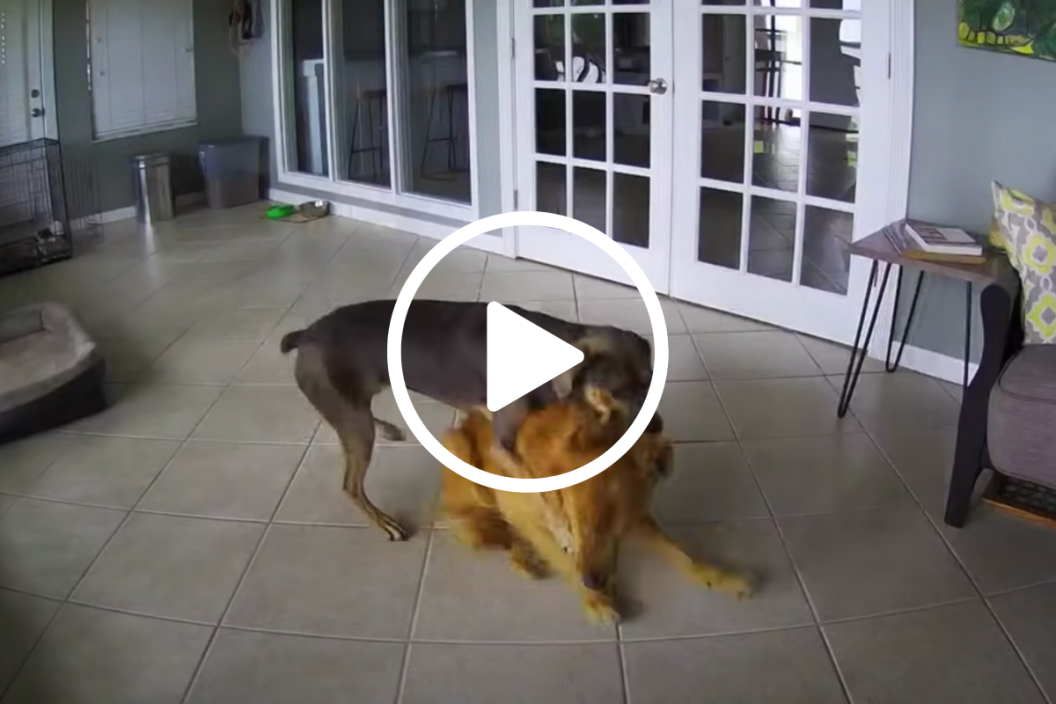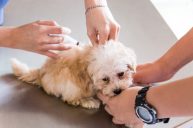Dogs flopping on the ground, convulsing is not normal for play. As a pet owner, you may wonder, "Is this what a dog seizure looks like?"
One of the most terrifying things a dog owner can ever experience is their fur baby having a seizure. If you have never seen one, you may wonder what a dog seizure looks like, and what is it really?
Seizures are caused by abnormalities in your dog's system, some of which can be life-threatening. A dog's brain is where seizures happen — Litte bursts of electrical activity come from the brain affecting their neuro system, which controls how they move, look, and behave.
Laker, the Golden Retriever, has had seizures since he was a pup. In this viral video from May 2021, he begins to have a seizure, and his pal, a Catahoula named Roxy, comes over, jumps on top of him to calm him down. Her actions pull him out of the seizure, and he calms down immediately.
Catahoula Stops Golden Retriever Mid-Seizure
Laker has what vets call psychomotor seizures, where he gets confused and runs around. But, the seizures are controlled by medication. However, this gives a look into what a dog seizure can look like, but it's not what all seizures look like.
What Does A Dog Seizure Look Like?

Getty Images
Dog seizures can look different for each pup, especially when it comes to severity. The type of seizure plays a lot into how it presents in your pup. Some dogs, like Laker, deal with seizures their entire lives and are on medication to manage it, so when they actually do have a seizure, the experience is not as jarring for the pup and their owner. It may look a bit different for pups who are experiencing their first seizure or have severe or cluster seizures. Some have stiffening, involuntary urination or defecation, or convulsions; they may also have all of the symptoms. Dogs can also experience a loss of consciousness during or right after the seizure.
The first time my dog, Paisley, had a seizure, her entire body went rigid, falling over almost in slow motion onto the deck. Her legs went stiff, and her breathing was labored. She lay on the deck for a second before her legs began to make rapid paddling movements. Foam began to form in my dog's mouth, drooling down the side of her face. Her mouth made chomping movements with snarling and whimpering sounds coming out of her convulsing body.
The craziest part of her seizure was when it was all over. She lay there very still for about a minute before getting up, shaking, and walking over to me with her tail wagging like nothing ever happened, much like Laker did in the video.
Granted, that is not the case with all dogs and certainly was not the case as time went on for Paisley, even after her vet put her on anticonvulsants. However, disorientation is very common for dogs after they have a seizure. Pups can be a bit wobbly and seem not to know where they are. It can take a couple of minutes for them to get their bearings.
Causes Of Seizures
Many different things can cause a seizure. some of the common causes are the following:
- Electrolyte deficiency
- Low Blood Sugar
- Liver disease
- ?Brain damage
- Kidney disease
- ?Anemia
- Consuming poison
- Strokes
- Brain tumor or cancer
It may be hard for vets to pinpoint the exact cause of your dog's seizures. Generally, they will start with a physical exam and blood tests. In the meantime, your vet with start your dog on a course of anticonvulsants to get their seizures under control. Some dog breeds are genetically predisposed to having seizure activity. Idiopathic epilepsy is common in border collies, Australian shepherds, Labrador retrievers, beagles, Belgian Tervurens, collies, and German shepherds. According to Pets WebMD, it is generally diagnosed between 6 months and 6 years of age, and pet parents are given a treatment plan that their pup will remain on for the rest of their lives.
Types of Seizures
There are many different types of seizures. However, some of the main types of seizures are the following:
- Generalized seizures: also known as grand mal seizures, are on both sides of the brain and may cause unconsciousness, stiffness, twitching, and other symptoms.
- Epileptic seizure: caused by epilepsy.
- Focal seizures: also known as partial seizures and occur in a part of your dog's brain. Dog's generally do not lose consciousness.
- Idiopathic epilepsy: the most common cause of seizures, where no underlying condition can be found.
- Status epilepticus: a generalized seizure that lasts more than 5 minutes or a cluster of seizures that renders the dog unconscious.
- Psychomotor seizure: causes sudden, odd behavior in dogs, like tail chasing and running.
Post-ictal refers to the time frame after your dog has a seizure; it is a 24-hour period of recovery time. Dogs can be disoriented, tired, and not at all like themselves. For example, Paisley would get a surge of adrenaline right after her seizure was over, where it is almost like the zoomies, and then proceed to pace. The pacing helps your dog get their bearings again.
Sometimes the underlying cause of a seizure can be difficult to determine. In Paisley's case, her vet could not determine the cause with blood tests, but it was likely that she had a brain tumor with how fast it all progressed. Plus, she was a border collie, Australian shepherd, Labrador retriever mix, and all three of those breeds are known to have seizure disorders.
Treating Seizures

Getty Images
Your vet can treat seizures, but once they start, it is rare for them to stop. When your dog has a seizure, try to keep them calm, but stay away and time it if you can. If a seizure lasts for longer than 5 minutes, you need to immediately call your vet or get in to see your emergency DVM. If your dog has multiple seizures within a 24-hour period, they need to be seen by the vet as well.
When Paisley's seizures became more consistent, she had a severe one while we were waiting for her blood work to come back from her vet. We took her to the emergency vet, who put her on a loading dose of phenobarbital, a strong narcotic. The high dose is meant to stop the seizures while your dog's body gets used to the new medication and comes down to the maintenance dose.
The loading dose can have some side effects. Your dog can be very disoriented, sleepy, and in Paisley's case, it made her very anxious and dependent. Not to mention she walked around like a drunk person for a couple of days. Once she settled into the maintenance dose after a couple of days, she was closer to her normal self. Though, it took a couple of weeks before she was completely back to herself.
Another drug that can be paired with the phenobarbital is potassium bromide. It is another anticonvulsant that is used when your dog cannot have a higher dose of phenobarbital but is still having severe seizures. When she had severe breakthrough seizures, Paisley began taking potassium bromide with her phenobarbital. It helped regulate her seizures and improve her quality of life.
If your pup is having seizures, consult with your vet on the best treatment course to get the symptoms under control and keep your pup comfortable.
Have you helped your dog with seizures? Share with us on our Wide Open Pets Instagram.




